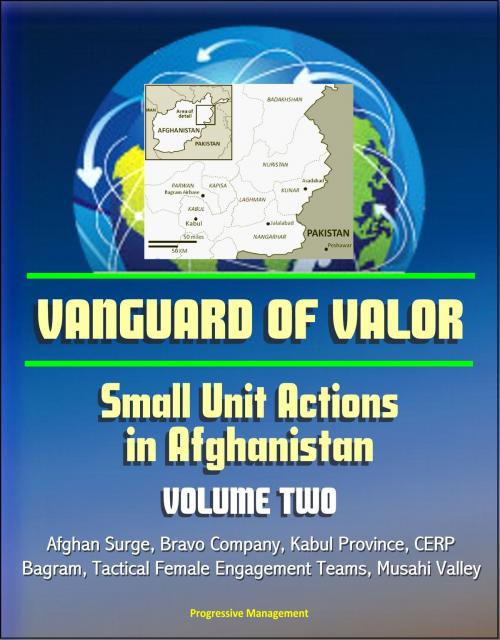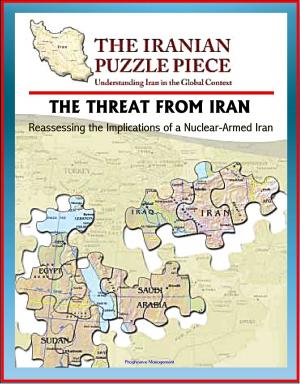Vanguard of Valor: Small Unit Actions in Afghanistan (Volume Two) - Afghan Surge, Bravo Company, Kabul Province, CERP, Bagram, Tactical Female Engagement Teams, Musahi Valley
Nonfiction, History, Military| Author: | Progressive Management | ISBN: | 9781311288387 |
| Publisher: | Progressive Management | Publication: | April 7, 2014 |
| Imprint: | Smashwords Edition | Language: | English |
| Author: | Progressive Management |
| ISBN: | 9781311288387 |
| Publisher: | Progressive Management |
| Publication: | April 7, 2014 |
| Imprint: | Smashwords Edition |
| Language: | English |
Beginning in 2009, the United States and many of its NATO-ISAF partners dramatically raised their levels of effort in Afghanistan. The "Afghan Surge," as it came to be known, was most evident in the number of additional US and allied troops that arrived in Afghanistan in 2009 and 2010. Their mission was clear: To reverse the Taliban's momentum and deny it the ability to overthrow the government, and to strengthen the capacity of Afghanistan's security forces and government so that they could assume lead responsibility for their nation's future.
For US Army units, the ways of creating stability and furthering the reach of the Afghan Government took several forms. First and foremost, US Soldiers executed complex and difficult offensive operations to seize territory that had often been held by insurgents for years. These combat actions were often complemented by civic action projects that were carried out together with US diplomats and development specialists. Additionally, US Soldiers formed close partnerships with Afghan Army and Police units to accelerate the growth of the Afghan security forces' capabilities.
At the heart of all of these efforts were the men and women who served in front line units during what has become longest war in our Nation's history. In my time as the senior US commander in Afghanistan and as US Ambassador to that country, I recognized that the success of the campaign depended greatly on the skill, valor, and grit of our Army Soldiers. This was true especially of the sergeants, lieutenants, and captains who make critical decisions under stressful combat conditions and interact on a regular basis with Afghan Soldiers and civilians.
The present volume, Vanguard of Valor II, offers six accounts of US Soldiers at the tip of the spear during the Afghan campaign. The Combat Studies Institute's Vanguard of Valor series is intended to document small unit actions in Afghanistan. These books play an equally important role by offering insights to Soldiers who may find themselves in the years ahead under similar conditions, whether in Afghanistan or in some other troubled land where they have been deployed to conduct the dangerous business of defending the national interest in a theater of war.
Contents: Chapter 1 - Toe to Toe with the Taliban - Bravo Company Fights in Makuan * Chapter 2 - Gaining the Initiative in Musahi - Using CERP to Disrupt the Taliban in Kabul Province * Chapter 3 - Partnership in Paktika Province, 2010-2011 * Chapter 4 - Leading the Charge - A Cavalry Platoon's Fight in Badghis Province * Chapter 5 - Combat Multipliers - Tactical Female Engagement Teams in Paktika Province * Chapter 6 - Securing Dan Patan - A US Infantry Squad's Counterinsurgency Program in an Afghan District
Beginning in 2009, the United States and many of its NATO-ISAF partners dramatically raised their levels of effort in Afghanistan. The "Afghan Surge," as it came to be known, was most evident in the number of additional US and allied troops that arrived in Afghanistan in 2009 and 2010. Their mission was clear: To reverse the Taliban's momentum and deny it the ability to overthrow the government, and to strengthen the capacity of Afghanistan's security forces and government so that they could assume lead responsibility for their nation's future.
For US Army units, the ways of creating stability and furthering the reach of the Afghan Government took several forms. First and foremost, US Soldiers executed complex and difficult offensive operations to seize territory that had often been held by insurgents for years. These combat actions were often complemented by civic action projects that were carried out together with US diplomats and development specialists. Additionally, US Soldiers formed close partnerships with Afghan Army and Police units to accelerate the growth of the Afghan security forces' capabilities.
At the heart of all of these efforts were the men and women who served in front line units during what has become longest war in our Nation's history. In my time as the senior US commander in Afghanistan and as US Ambassador to that country, I recognized that the success of the campaign depended greatly on the skill, valor, and grit of our Army Soldiers. This was true especially of the sergeants, lieutenants, and captains who make critical decisions under stressful combat conditions and interact on a regular basis with Afghan Soldiers and civilians.
The present volume, Vanguard of Valor II, offers six accounts of US Soldiers at the tip of the spear during the Afghan campaign. The Combat Studies Institute's Vanguard of Valor series is intended to document small unit actions in Afghanistan. These books play an equally important role by offering insights to Soldiers who may find themselves in the years ahead under similar conditions, whether in Afghanistan or in some other troubled land where they have been deployed to conduct the dangerous business of defending the national interest in a theater of war.
Contents: Chapter 1 - Toe to Toe with the Taliban - Bravo Company Fights in Makuan * Chapter 2 - Gaining the Initiative in Musahi - Using CERP to Disrupt the Taliban in Kabul Province * Chapter 3 - Partnership in Paktika Province, 2010-2011 * Chapter 4 - Leading the Charge - A Cavalry Platoon's Fight in Badghis Province * Chapter 5 - Combat Multipliers - Tactical Female Engagement Teams in Paktika Province * Chapter 6 - Securing Dan Patan - A US Infantry Squad's Counterinsurgency Program in an Afghan District















